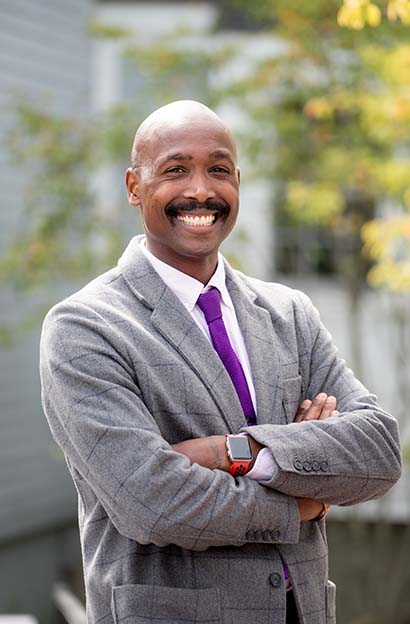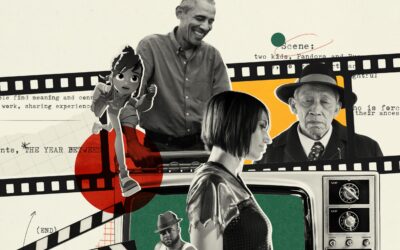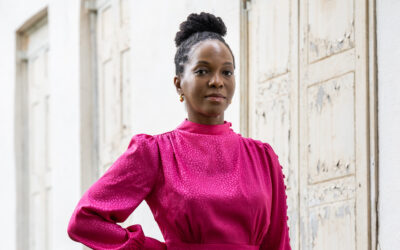
Robert Munro, Concord Academy’s dean of academic program and equity, stepped into this newly created role in July. He previously directed the global studies program at Middlesex School, where he also taught history. At CA, he is tasked with envisioning how equity, sustainability, and social justice can be woven into the fabric of CA’s rigorous academics; building institutional capacity among leadership, faculty, and staff around diversity, equity, and inclusion; and inspiring a community already engaged in this work to delve deeper. His challenge is to help CA evolve in accordance with its mission.
What drew you to CA?
When I learned about this position, I thought, it’s like they’ve made a job explicitly for me — this is what I’ve been working toward, and that was exciting.
How is the mission guiding your approach?
Missions are useless until they’re mobilized. Making the mission work for the program will take time, effort, and, yes, discomfort. People are already doing the work of inclusion at CA in so many areas, and my task is to build on that foundation while working to break down the silos that are inherent in academic life. If we’re all cohering around the idea of equity, we will be more interdisciplinary and more inclusive. For a long time, a lot of diversity work has been seen as “that thing over there.” When it’s like that, there’s not really a foundation for it. But if it’s the work of everybody at the school, that’s where it gets legs.
What does it look like for equity to infuse a curriculum?
We work in independent schools because we want to teach independently, and we want faculty to try new and innovative things. Students also value equitability and transparency. Often independence and equitability are opposed, but we can bring them together. This involves equity in curriculum content, and in standardization of assessments and comments, without being rigid. It also involves developing anti-bias communication protocols. If something comes up, any sort of verbal inequality that people experience, students want to know that we’re taking it seriously, and faculty and staff need a process for that.
How are you working with different members of our community?
Already students have been reaching out to share their experiences and thoughts, and parents have been asking good and tough questions. Structurally, the Community and Equity Office will spearhead a lot of this work. In a traditional model, you have a program in, say, October and people like it, but they’re too busy to follow up. That model doesn’t offer sustainable growth in anti-bias work. Instead of focusing on separate programs, I’m trying to touch every constituency at CA. We began the year with training for senior administrators, trustees, and faculty and staff. Students are taking part in ongoing workshops. And we’re reaching out to alumnae/i and parents through reading groups and Zoom meetings. Even though it’s not all happening at the same time, we’re still doing this work together, so when students talk with their parents, we’re having similar conversations.
How did CA change academic structures to ensure equity during a period of distance learning?
The readiness of faculty to be innovative and creative went into creating a new structure for this year. Lots of teachers have been excited by the new schedule we’re following, which was developed with significant value placed on equity of access for all students in a way that not every school is prioritizing. Our approach to structuring the school day and the year’s schedule balances the rigor of our academic program with health and wellness, collaboration, and support. There’s time set aside for memorable, out-of-the-box learning and enrichment programming, and opportunities for teachers and students to work collaboratively every week.
Why do you enjoy working with high school students?
I was a terrible student through high school. It was in college that I found my love of reading and learning and talking with faculty and being around intelligent people. I didn’t know I wanted to be a teacher, even in graduate school. I figured it out when I needed a job. When I taught at the college level, though, it seemed incredibly transactional. In contrast, what I like about high school-aged kids is that they’ll try things, ask questions without worrying about seeming naive, and they will find moments to learn when no learning is seemingly evident. I stumbled into this, but I’ve grown and learned as I keep doing it, and I’m so glad I found it.
You consult about empathy, a quality seemingly in short supply in these difficult days. What perspective can you offer for CA?
We thought empathy was in short supply when I started researching that area five or six years ago. It’s gotten a lot worse. Empathy is not just abstract; it has real implications. We’ll do very well if we can remember that we should assume a small amount of risk and sacrifice for the greater community. “I can be comfortable being uncomfortable” is a saying I’ll probably have on my headstone when I’m buried, but that’s really my hope for the school — that we do that in increments, that we tell each other, “It’s not my idea, but because it will benefit the community, I will do it.” If we do it, we’ll be better off than most schools.
Learn more:
Read Head of School Rick Hardy’s letter of introducton to Rob Munro.


